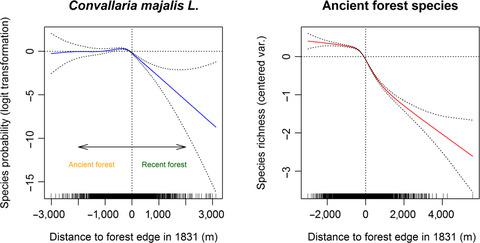当前位置:
X-MOL 学术
›
Journal of Vegetation Science
›
论文详情
Our official English website, www.x-mol.net, welcomes your
feedback! (Note: you will need to create a separate account there.)
Historical ecology and ancient forests: Progress, conservation issues and scientific prospects, with some examples from the French case
Journal of Vegetation Science ( IF 2.2 ) Pub Date : 2019-12-07 , DOI: 10.1111/jvs.12846 Laurent Bergès 1 , Jean‐Luc Dupouey 2
Journal of Vegetation Science ( IF 2.2 ) Pub Date : 2019-12-07 , DOI: 10.1111/jvs.12846 Laurent Bergès 1 , Jean‐Luc Dupouey 2
Affiliation

|
Forest area has dramatically increased since the beginning or middle of the 19th century in European countries. At least half of the forests present today have grown on formerly cultivated lands, pastures or heathlands. However, net forest expansion largely masks a slow but irretrievable erosion of ancient forests. Meanwhile, forest resource harvesting (biomass, litter) has fundamentally changed during the last two centuries, moving from intensive biomass removal to increased growing stocks in different European countries. This article reviews the current knowledge on the long‐term legacies of past land use and forest management practices and their effects on the functions, diversity and composition of understory vegetation of current forest ecosystems. First, we define the concepts of forest continuity and ancient forest. Then, based on the French case, we present the advances in historical sources, which make it possible to better reconstruct the change in land use and forest management practices over the last two hundred years. We review how understory plant communities and their traits respond to forest continuity and to different types of former agricultural uses, both at local and landscape scales. We then address three important issues for conservation and management: the conservation value of ancient forests, the impact of forest management on the ecological integrity of ancient forests, and the under‐explored legacies of former forest management practices on soil and understory vegetation. Lastly, we propose five main fronts for future research efforts: (a) explore all types of cartographic, written sources and environmental markers; (b) develop modelling approaches to understand how past land use shapes plant communities; (c) better define the conservation value of ancient forests in conservation and management policies; (d) investigate how drivers of global change interact with forest management and land use legacies and (e) explore land use legacies in mountain and Mediterranean socio‐ecological systems.
中文翻译:

历史生态学和古代森林:进展,保护问题和科学前景,以法国案例为例
自19世纪初或上世纪以来,欧洲国家的森林面积急剧增加。今天至少有一半的森林生长在以前的耕地,牧场或荒地上。但是,森林净扩张在很大程度上掩盖了古代森林缓慢而无法挽回的侵蚀。同时,在过去的两个世纪中,森林资源的采伐(生物质,凋落物)发生了根本性的变化,从密集的生物质去除到增加的欧洲不同国家的蓄积量。本文回顾了有关过去土地使用和森林管理实践的长期遗产的最新知识,以及它们对当前森林生态系统下层植被的功能,多样性和组成的影响。首先,我们定义森林连续性和古代森林的概念。然后,基于法国的案例,我们介绍了历史资源的进展,这使得有可能更好地重建过去200年中土地利用和森林管理实践的变化。我们回顾了林下植物群落及其特征如何响应森林的连续性以及在地方和景观尺度上对不同类型的前农业用途的反应。然后,我们讨论了三个重要的保护和管理问题:古代森林的保护价值,森林管理对古代森林的生态完整性的影响以及以前森林管理实践对土壤和林下植被的探索不足。最后,我们为未来的研究工作提出了五个主要方面:(a)探索所有类型的制图,书面资源和环境标志;(b)开发建模方法,以了解过去的土地利用如何影响植物群落;(c)在保护和管理政策中更好地界定古代森林的保护价值;(d)调查全球变化的驱动因素如何与森林管理和土地利用遗产互动,以及(e)探索山区和地中海社会生态系统中的土地利用遗产。
更新日期:2019-12-07
中文翻译:

历史生态学和古代森林:进展,保护问题和科学前景,以法国案例为例
自19世纪初或上世纪以来,欧洲国家的森林面积急剧增加。今天至少有一半的森林生长在以前的耕地,牧场或荒地上。但是,森林净扩张在很大程度上掩盖了古代森林缓慢而无法挽回的侵蚀。同时,在过去的两个世纪中,森林资源的采伐(生物质,凋落物)发生了根本性的变化,从密集的生物质去除到增加的欧洲不同国家的蓄积量。本文回顾了有关过去土地使用和森林管理实践的长期遗产的最新知识,以及它们对当前森林生态系统下层植被的功能,多样性和组成的影响。首先,我们定义森林连续性和古代森林的概念。然后,基于法国的案例,我们介绍了历史资源的进展,这使得有可能更好地重建过去200年中土地利用和森林管理实践的变化。我们回顾了林下植物群落及其特征如何响应森林的连续性以及在地方和景观尺度上对不同类型的前农业用途的反应。然后,我们讨论了三个重要的保护和管理问题:古代森林的保护价值,森林管理对古代森林的生态完整性的影响以及以前森林管理实践对土壤和林下植被的探索不足。最后,我们为未来的研究工作提出了五个主要方面:(a)探索所有类型的制图,书面资源和环境标志;(b)开发建模方法,以了解过去的土地利用如何影响植物群落;(c)在保护和管理政策中更好地界定古代森林的保护价值;(d)调查全球变化的驱动因素如何与森林管理和土地利用遗产互动,以及(e)探索山区和地中海社会生态系统中的土地利用遗产。











































 京公网安备 11010802027423号
京公网安备 11010802027423号